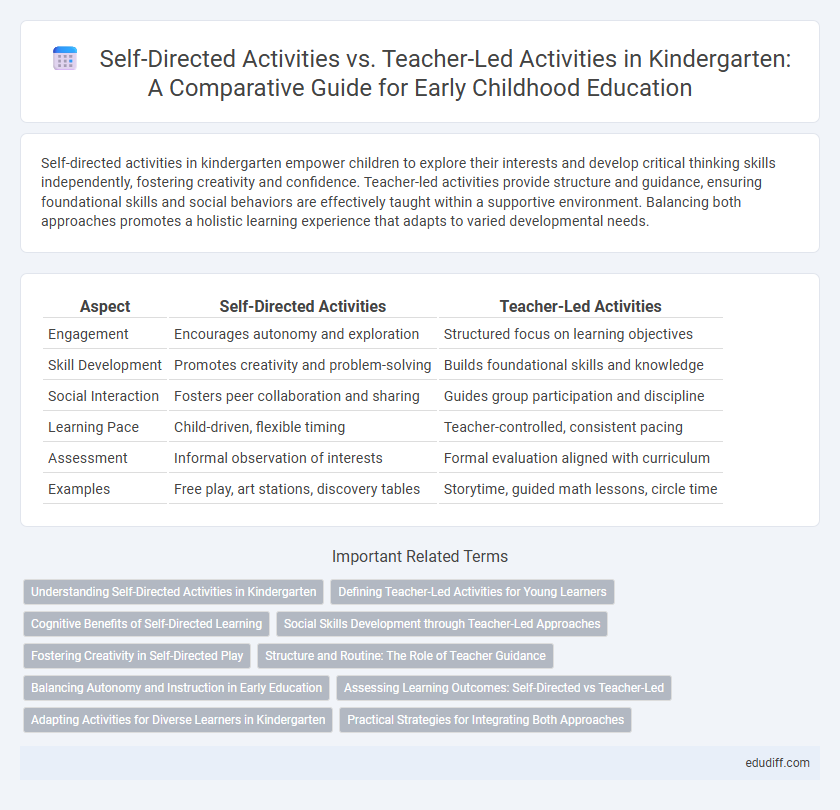Self-directed activities in kindergarten empower children to explore their interests and develop critical thinking skills independently, fostering creativity and confidence. Teacher-led activities provide structure and guidance, ensuring foundational skills and social behaviors are effectively taught within a supportive environment. Balancing both approaches promotes a holistic learning experience that adapts to varied developmental needs.
Table of Comparison
| Aspect | Self-Directed Activities | Teacher-Led Activities |
|---|---|---|
| Engagement | Encourages autonomy and exploration | Structured focus on learning objectives |
| Skill Development | Promotes creativity and problem-solving | Builds foundational skills and knowledge |
| Social Interaction | Fosters peer collaboration and sharing | Guides group participation and discipline |
| Learning Pace | Child-driven, flexible timing | Teacher-controlled, consistent pacing |
| Assessment | Informal observation of interests | Formal evaluation aligned with curriculum |
| Examples | Free play, art stations, discovery tables | Storytime, guided math lessons, circle time |
Understanding Self-Directed Activities in Kindergarten
Self-directed activities in kindergarten foster independence, creativity, and critical thinking by allowing children to explore and learn at their own pace. These activities include free play, art projects, and hands-on experiments that encourage decision-making and problem-solving skills. Research shows that self-directed learning helps develop intrinsic motivation and supports social-emotional growth in early childhood education.
Defining Teacher-Led Activities for Young Learners
Teacher-led activities in kindergarten are structured learning experiences guided by the educator, designed to introduce foundational concepts such as letters, numbers, and social skills. These activities include group instruction, storytime, and teacher-directed games, creating an environment where young learners receive clear guidance and immediate feedback. Emphasizing consistency and repetition, teacher-led activities support cognitive development and classroom routines essential for early childhood education.
Cognitive Benefits of Self-Directed Learning
Self-directed activities in kindergarten foster critical thinking, problem-solving, and creativity by encouraging children to explore concepts independently. These activities promote intrinsic motivation and enhance memory retention compared to teacher-led tasks, which often rely on direct instruction. Research in early childhood education highlights that self-directed learning significantly supports cognitive development by allowing children to process information at their own pace and apply knowledge in meaningful contexts.
Social Skills Development through Teacher-Led Approaches
Teacher-led activities in kindergarten provide structured opportunities for children to engage in guided social interactions, enhancing skills like sharing, cooperation, and conflict resolution. Through role-playing, group discussions, and turn-taking exercises facilitated by teachers, children learn appropriate social behaviors and communication strategies. These approaches create a supportive environment where social skills are explicitly taught and reinforced, leading to improved peer relationships and emotional regulation.
Fostering Creativity in Self-Directed Play
Self-directed play in kindergarten nurtures creativity by allowing children to explore materials, ideas, and scenarios at their own pace, fostering originality and problem-solving skills. Teacher-led activities provide structure and guidance that help develop foundational skills, but self-directed activities encourage independent thinking and imaginative expression. Research indicates that balancing both approaches enhances cognitive flexibility and supports holistic creative development in early childhood education.
Structure and Routine: The Role of Teacher Guidance
Teacher-guided activities in kindergarten provide essential structure and routine, helping children develop a sense of security and predictability throughout the day. Self-directed activities foster independence and creativity but thrive best when grounded within a consistent framework established by the teacher. The balance between structured teacher-led sessions and flexible self-directed play supports holistic development and effective classroom management.
Balancing Autonomy and Instruction in Early Education
Balancing autonomy and instruction in early education involves integrating self-directed activities, which foster creativity, problem-solving, and independence, with teacher-led activities that provide structured guidance and foundational skills. Research indicates that combining both approaches enhances cognitive development and social-emotional growth in kindergarten children. Implementing a flexible curriculum that adapts to individual learning styles supports optimal engagement and academic readiness.
Assessing Learning Outcomes: Self-Directed vs Teacher-Led
Assessing learning outcomes in kindergarten reveals distinct advantages between self-directed and teacher-led activities; self-directed tasks foster problem-solving skills and intrinsic motivation by allowing children to explore concepts at their own pace, while teacher-led activities provide structured guidance that ensures mastery of specific academic targets. Observational assessments during self-directed play highlight creativity and decision-making, whereas teacher-led assessments typically measure comprehension and skill acquisition against curriculum benchmarks. Combining both approaches offers a comprehensive evaluation of cognitive, social, and emotional development in early childhood education.
Adapting Activities for Diverse Learners in Kindergarten
Adapting activities for diverse learners in kindergarten involves balancing self-directed activities and teacher-led instruction to meet each child's unique developmental needs. Self-directed activities promote autonomy and creativity, allowing children to explore concepts at their own pace, while teacher-led activities provide structured guidance and targeted skill development essential for foundational learning. Integrating both approaches supports differentiated instruction, fosters inclusive classroom environments, and addresses varying learning styles, ensuring all children engage meaningfully and achieve early educational milestones.
Practical Strategies for Integrating Both Approaches
Balancing self-directed activities with teacher-led sessions enhances kindergarten learning by promoting independence alongside guided instruction. Practical strategies include establishing clear routines, offering choice within structured frameworks, and using observation to tailor support based on individual student needs. Integrating these approaches fosters creativity, critical thinking, and a supportive environment for diverse learning styles.
Self-directed activities vs Teacher-led activities Infographic

 edudiff.com
edudiff.com